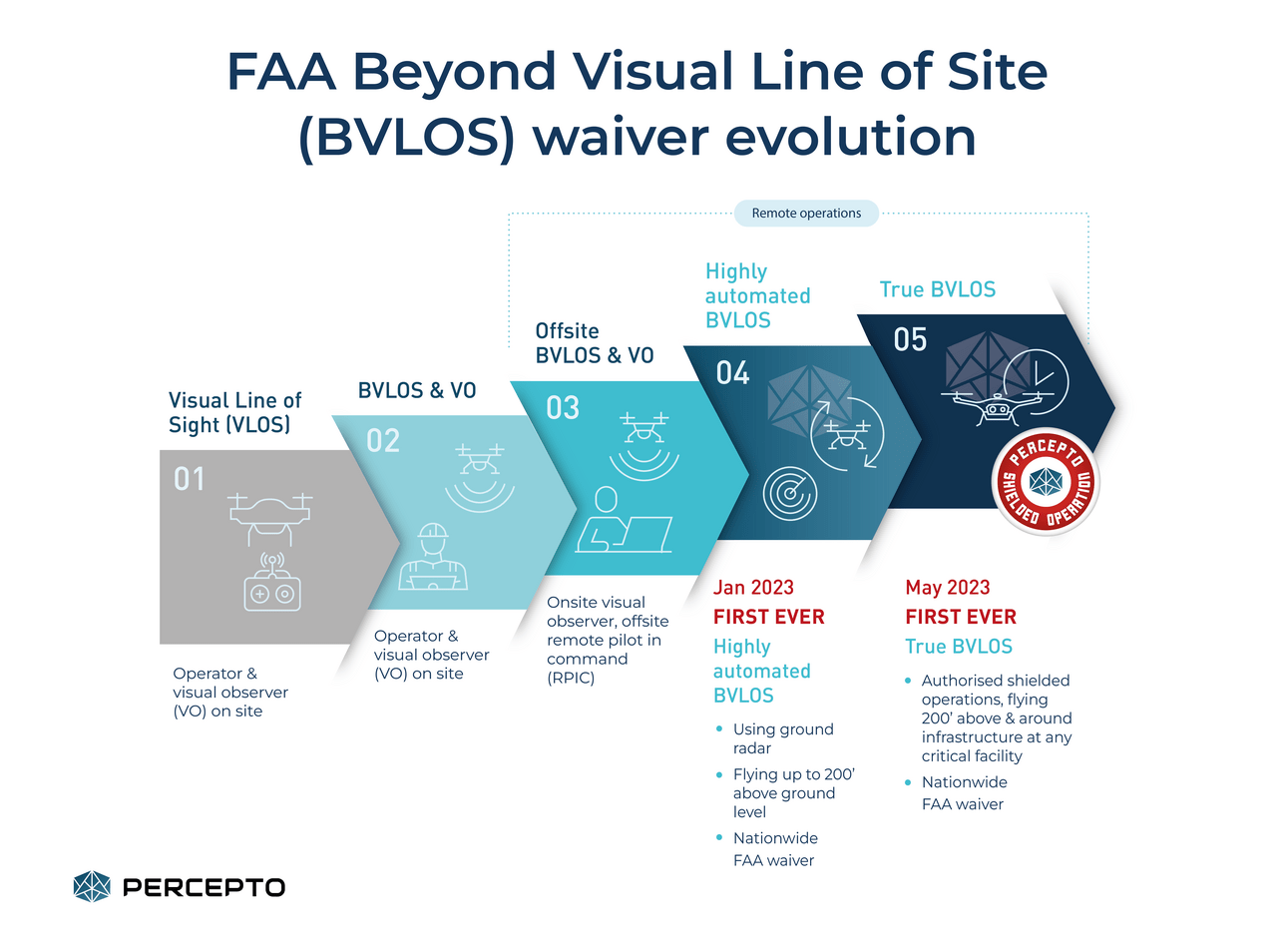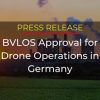Anyone who has ever bought a new car knows the feeling—once the keys are in your hand, you can’t wait to take it out on the road. The same is true for companies who purchase a drone-in-a-box (DIB)—they want to start using it right away, without lengthy delays for regulatory approvals, and without having to buy additional expensive safety equipment. However, before the FAA issued a game-changing “true BVLOS” waiver for DIBs, there was no other option.
That changed for US based customers in May 2023, when the FAA issued a waiver that enables Percepto pilots to operate uncrewed aircraft systems (UAS) beyond visual line of sight (BVLOS) in shielded airspace, without humans on site, and without expensive and cumbersome ground-based detect and avoid (DAA) systems such as radar systems. With the new waiver, there is no waiting period—companies can set up their drone and start using it right away. It’s the DIB equivalent of being able to drive your car out of the dealership lot the minute the salesperson hands you the keys.
Gathering speed: the progression of regulation
The current waiver wasn’t issued in a vacuum. The regulatory landscape is constantly evolving, and over the past several years, Percepto has been working closely with the FAA, proving the company’s dedication to safety and the reliability of the Percepto system. In fact, Percepto team members were active contributors in the landmark report by the Federal Aviation Administration’s (FAA) Beyond Visual Line of Sight (BVLOS) Aviation Rulemaking Committee (ARC), which helped pave the way for the current waiver.
Our work with regulators has become a process of cross-fertilization. As Christopher Doherty, Aviation Safety Inspector, FAA AFS-830 Special programs, said in the Percepto panel at Xponential 2023, “We’re asking industry to push us into more forward-thinking so we can stay ahead of the curve about getting all of these waivers out for these particular operations.”

Enter the era of “True BVLOS”
The latest waiver is truly revolutionary because it allows companies to conduct inspection and monitoring flights remotely, with a pilot located anywhere in the US, with no need for humans onsite or for detect and avoid (DAA) systems.
Under the waiver, low-risk “shielded” BVLOS operations are authorized 200 feet above and around assets located at critical infrastructure sites. And at non-critical infrastructure sites, shielded BVLOS operations are permitted 50 feet higher than the tallest obstruction located within a half-mile of the site.
Even the previous highly automated BVLOS waiver required either two people on-site – a pilot and a visual observer – or costly ground radar systems to ensure clear airspace. The current waiver eliminates those requirements, opening the door to major savings for anyone who operates any kind of critical or non-critical infrastructure in the United States.
This waiver, while nationwide, is currently limited to Percepto drones. It means companies operating a Percepto drone can conduct such BVLOS operations without having to apply for any special waivers or exemptions. They’re ready to fly from day one!
The new look of autonomous inspection
With true BVLOS, critical infrastructure located in remote areas can now be inspected with the same frequency and granularity as infrastructure anywhere, with minimal, or even zero, marginal cost, beyond the cost of the drone-in-a-box itself. A single control center located anywhere in the US can manage inspections of well heads, oil tanks, solar fields, pipelines, and more.
“In a manual operation, you send a pilot out to the field with a drone, with a payload, an optical gas imaging camera. They physically have to set everything up, do their safety procedures, cool the camera, do those inspections manually,” says Danny Allen, Geospacial Intelligence Supervisor, ConocoPhillips. “So, you’re driving back to the office, you’re uploading that data, and now you introduce a whole other aspect of reviewing all that data. So, we’re looking at about a three-day time span before we can inspect something and give a report. … [Now] we’re able to generate those reports, give those reports back to the team the next morning, and they can go and do the repairs.”
Michael Hull, Director of Generation Technology, Vistra Corps, agrees. “Solar sites are not staffed 24/7 by any stretch, two days at most. And we want those folks, when they’re out there turning wrenches, fixing things rather than having to do inspections…It used to be if we wanted to get inspection data and that good information about where our opportunities are, we had to pay for it. Now that we’re completely autonomous it’s changed to ‘how can I be flying these drones more frequently? What else can I be doing to generate value?’ rather than looking at how do I minimize the cost of my inspections. And that completely changes the model for what you’re going to do with an asset like this.”
Conclusion
The new “true BVLOS” waiver is ushering in a new era of completely remote ConOps for inspection and monitoring operations at critical and non-critical infrastructure sites nationwide. Any company can start leveraging that potential today, with Percepto.





